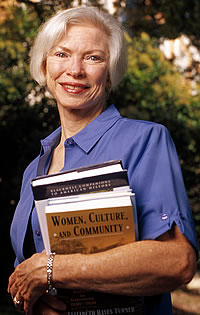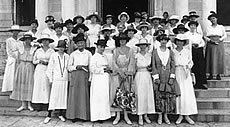 |
|||||||||||||||||

Women's Suffrage Movement in Texas Iron Petticoats |
With today's high-level representation of women in politics, it's hard to fathom that until 84 years ago they couldn't vote in most states. Women voters wouldn't breast-feed their babies, opponents railed. They'd be raped at the polls. Men would be henpecked. Even the Bible was brought into the argument: Paul proclaimed women are justly under male authority.
Against such attitudes, winning the vote through the 19th Amendment in 1920 was a hard slog. But unlike their more radical Northern sisters, Texas suffragists fought like ladies, says UNT associate history professor Elizabeth Hayes Turner, who studies Southern women's history of the Progressive Era and wrote Women, Culture and Community: Religion and Reform in Galveston, 1880-1920. Northern suffragists marched and picketed — even chained themselves to the White House fence — and were jailed and beaten. "Southern women just didn't act that way because gentility proved more potent," says Turner, now writing The Transformation of the Texas Woman Suffrage Movement. "They were ladies. They used the militant women as a foil by saying, 'We are the true proponents of suffrage, and we are reserved and restrained.'" Turner says she became interested in woman suffrage in the South through fascination that women in "this most conservative region of the nation … could take on the most radical cause of that time. I wanted to know how that could happen." Social reform The Texas woman suffrage movement, Turner learned, evolved from self-improvement clubs, considered the proper pastime of urban Southern women. The Texas approach was milder, but there was iron aplenty in their petticoats. The clubs often tackled social reforms critical in a rapidly urbanizing state — campaigns for children's playgrounds, "They struggled to get ordinances passed before the era of state standards," Turner says. "They were frustrated when male legislators wouldn't listen because they didn't vote, and that turned many into activists. Most approached suffrage from the perspective of having more clout if they had the vote."
Austin women in 1908 were among the first to form a viable woman suffrage association, and by 1918, there were almost 100 local suffrage leagues around the state. Women were involved in most of the larger cities, but Denton wasn't among them. Nor was Fort Worth. "There weren't enough women interested to make a movement there," notes Turner. Though traditional ladies, Texas suffragists were persistent, and their tactics could be remarkably sophisticated. Minnie Fisher Cunningham, who lived for a time in Galveston, became president of the Texas Equal Suffrage Association in 1915. She kept a card file on the suffrage stance of every state legislator. She'd march boldly into opponents' offices and buttonhole them in suffrage debates. But Turner points out that it wasn't only persistence that helped Texas suffragists. Growing urbanization helped greatly. The railroad connected formerly isolated communities, and automobiles and telephones were making inroads. Families left the farm for better opportunities in the city, where middle-class wives had the leisure time for clubs. "From club work, they realized how ineffective their desire for reform was without the vote," Turner says. By 1918, Texas women had won the vote in state primary elections. That limited vote didn't last long. With Congressional passage of the 19th Amendment in June 1919, the amendment went to the states for ratification. On June 28, 1919, Texas became the first Southern state to ratify the amendment. Ratification by the final state, Tennessee, came Aug. 18, 1920. "The right of citizens of the United States to vote shall not be denied or abridged by the United States or by any state on account of sex" was now the law.
But there was an ugly side of the Texas movement also. It was exclusively for white women; African Americans weren't allowed. "If black women joined the movement, the (white) women felt white men wouldn't support it," explains Turner. "The only way women were going to get the vote was if men voted for it." The suffragists' solution was the Texas poll tax, passed in 1902, which they knew would keep black women from voting just as it barred most African American men. The $1.50 annual voting fee was too expensive. The poll tax, though, also had the unintended effect of disfranchising poor white women, Turner adds. If there was only enough money for one poll tax fee in a family, the vote invariably went to the man. The voting tax wasn't banned until 1964, with passage of the 24th Amendment. After 1920, a woman's right to vote was at least enshrined in the Constitution. But as the plight of black and poor women shows, its exercise didn't come without further struggle.
And for the suffragists, the vote didn't mean automatic political equality as many envisioned. Elected female officials were rare for two more generations.
| ||||||||||||||||||||||

